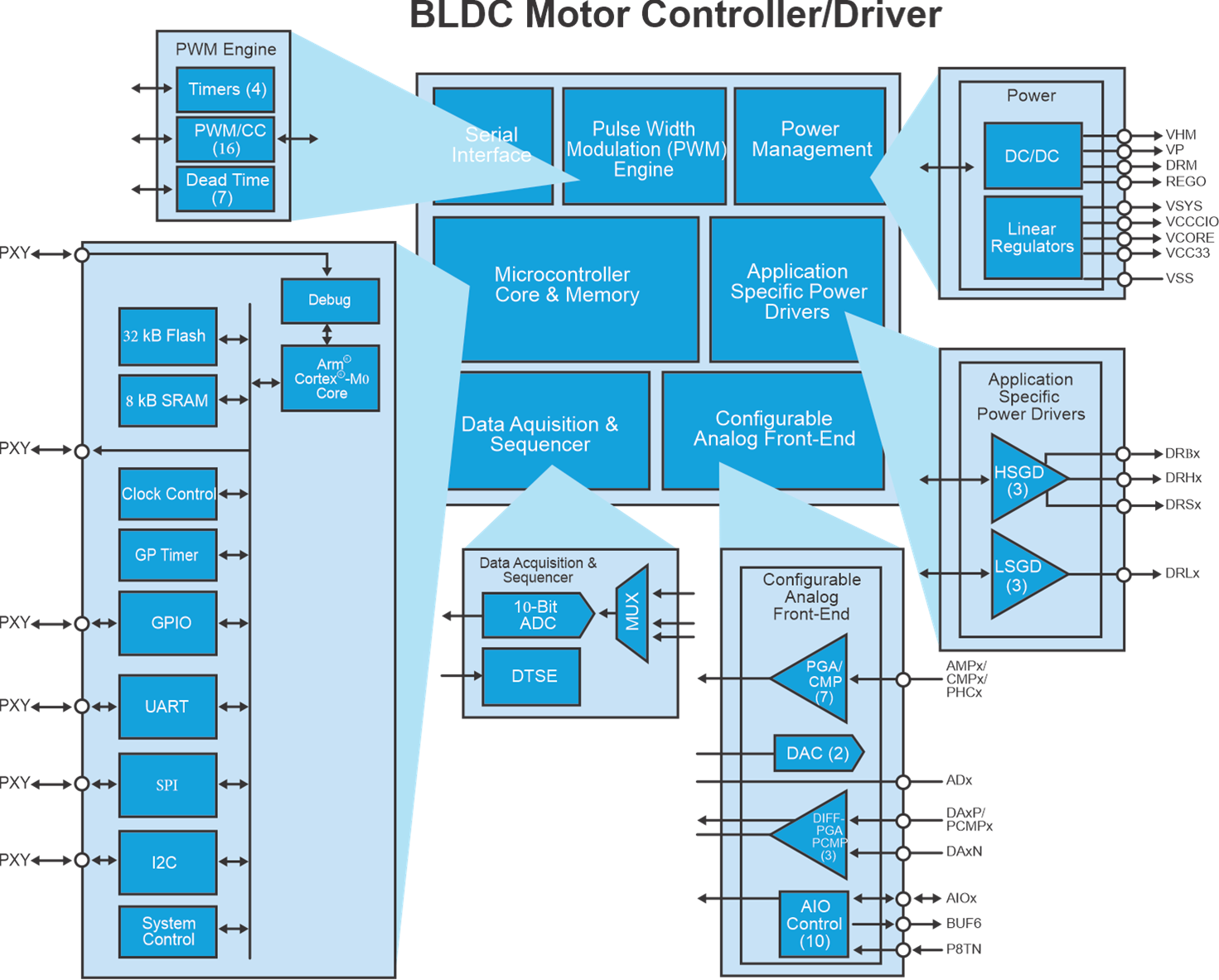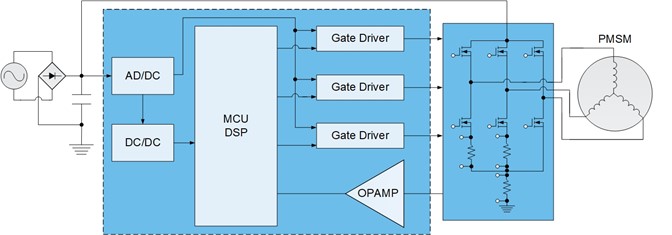Modern Motor Design Cleans Up the Portable Vacuum
July 31, 2021
The 21st century home offers abundant examples of how a simple, everyday device - the electric motor - has evolved through modern design to become an integral part of an expanding number of home appliances. Inside the home, you can find electric motors in refrigerators, computers, microwave ovens, fans, washing machines, and vacuum cleaners. Outside the home, motors are present in garage door openers, shop vacuums, garden trimmers, cordless tillers, electric lawn mowers, pressure washers, and other yard equipment.
We have come a long way since the early 20th century where simple A/C induction and Brushed DC motors powered washing machines, refrigerators, and fans. Today's motor designs have advanced to Brushless DC style. This design accommodates consumer preferences, providing greater efficiency, powering cordless devices for extended periods, fitting into smaller and lighter devices, and offering extended reliability. A study conducted by the Advisory Committee on Energy Efficiency (ACEE), an adjunct of the International Electrotechnical Commission (IEC) determined, "Electric motor systems represent more than 50% of the global electricity used, of which the large majority of electric motors are used in machines, pumps, fans, compressors, conveyor belts, etc. It is a genuine opportunity to increase energy efficiency."

This blog post looks at an engineering project in which Qorvo helped meet the design specifications for a high-power cordless vacuum cleaner using an advanced PMSM (permanent magnet synchronous motor) to deliver an unusually high level of power and speed.
Trends in the global vacuum cleaner market
Globally, the market for vacuum cleaners reached USD 9.2 billion in 2018. According to Grand View Research, this market shows strong growth. They project the CAGR will be 9.1% during the forecast period from 2019 to 2025, driven by an increasing population of working women and new consumer expectations related to rising standards of living.
A significant portion of this market growth is fueled by consumer preferences for energy-efficient appliance operation and environmental concerns. Another growth factor is increasing demand for workplace vacuum cleaners to reduce hazardous dust and improve hygiene practices in environments, including hospitals, manufacturing centers, retail stores, and healthcare facilities.
Challenge
The vacuum cleaner design group involved in this project and Qorvo engineers were presented with a set of rigorous customer requirements for a cordless vacuum cleaner. The resulting design combines high-speed motor operation for maximum suction, a lightweight form factor, and components selected for a long, reliable product lifecycle. The level of suction specified for this vacuum was higher than most conventional portable vacuum cleaners. Another consideration affected design decisions as well: In most vacuum cleaner designs, the important factors are torque and motor speed. The requirements in this case, however, were slightly different, emphasizing the need for power and speed.
The customer design specifications called for a PMSM motor equipped with field-oriented control (FOC) for variable frequency drive (VFD) capabilities to meet the product requirements.
Motor Design Acronym Guide
- ADC - Analog-to-Digital Converter
- BLDC - Brushless DC motors
- FOC - Field-Oriented Control
- IEC - International Electrotechnical Commission
- MCU - Microcontroller Unit
- PMSM - Permanent Magnet Synchronous Motor
- PWM - Pulse-Width Modulator
- VFD - Variable Frequency Drive
Solution
Qorvo and the design group began the project from an understanding that the end product would be a high-performance vacuum and, for that reason, chose a three-phase PMSM because of its use of sinewave commutation, which helps maximize performance. The design relied on FOC and uses an algorithm for controlling the stator’s revolving magnetic field, relying on two orthogonal components to regulate the magnetic flux generator and determine the available torque.
Use of the FOC and the custom algorithm developed by Qorvo enabled precise control over motor speed and made it possible to maximize the overall efficiency of the vacuum. The collaborative work between the design group and Qorvo over several months resulted in a product that successfully fulfilled the product requirements. As a result of this cooperative design effort, this powerful, efficient cordless vacuum cleaner is now available commercially.
Overview – vacuum cleaner operation
Handheld vacuums generate suction by spinning a motor-driven fan that pulls air through the head of the vacuum and —after trapping the ingested dust and debris in a bag or canister—expels it through an exhaust port. Typically, a filter placed in the exhaust stream prevents tiny particles from being discharged. The speed of the fan motor and the dimensions of the intake port (or accessory attachments) determine the degree of suction, ascertained by the negative pressure created when the air is drawn through the head and forcefully discharged from the exhaust. Fan speeds up to 100,000 revolutions per minute and above are commonly reached in high-end vacuums, such as the product design to which Qorvo contributed.
Key components of a high-power vacuum
To achieve maximum performance, modern handheld vacuum cleaners incorporate brushless DC (BLDC) motors, generating a rotating magnetic field within the motor enclosure. In this type of brushless design, the stator is stationary, with fixed coils, and permanent magnets are affixed to the rotor, which spins in response to the cycling magnetic fields. Current to the stator coils is precisely controlled by an external electronic motor controller, allowing variable rotational speeds to be produced. Advantages of the BLDC design, which is more complex but much more controllable than brushed DC and traditional induction motors, include highly efficient operation, a more compact footprint, greater reliability, and exceptional long-term durability.
The type of BLDC motor selected for this project was a three-phase PMSM, driven by a sinusoidal wave, which represents the best choice for meeting the high-performance requirements. The criteria for the project included:
- Ultra-high-speed motor capabilities
- Constant power control with over-voltage protection
- Quick start-up operation
- Cost-effective design components
The design features that enabled Qorvo and the team to satisfy these criteria are discussed in the following section.
Design highlights
The Qorvo PAC5225 IC, a member of the Qorvo Power Application Controller (PAC) family, is at the heart of the vacuum cleaner project design. This system-on-a-chip (SoC) provides full functionality for building a simple, compact, cost-effective motor control board (see Figure 2). The board in this design includes an integrated power management system, a 50 MHz, 32-bit ARM Cortex-M0 microcontroller unit (MCU), gate drivers, operational amplifiers, comparators, and other supporting components. Adding a peripheral MOSFET for delivering constant power output under variable conditions completes the integrated design.

Figure 1. Functional block diagram of the PMSM motor controller and drivers.
Achieving ultra-high-speed motor operation
Exceptional motor speed was an essential design parameter in this project, aimed at making it possible to reach levels substantially higher than standard vacuum cleaners on the market. To achieve a mechanical speed of up to 150,000 rpm required closely managing operation of the analog-to-digital converter (ADC) and the pulse-width modulator (PWM), which are controlled by the ARM Cortex M0 MCU. The electrical frequency required can range up to 2.5 kHz and — for precision FOC control — the ADC sampling speed and accuracy must be up to 1 MSPS and very fine resolution of the PWM is needed as well. The microcontroller ensures that these values are finely tuned for precise operation and the FOC algorithm developed by Qorvo is customized to meet these requirements and to accelerate the operational sequences of the FOC.
Regulating power for optimal results
Many different factors affect suction in a vacuum cleaner, including air duct volume of different attachments, battery levels, any ingested object that clogs the vacuum, and the exhaust filter getting saturated with dust and debris. This is where maintaining constant power under changing conditions is critical to maximizing suction. Designs based on the regulation of torque or motor speed don’t respond as well to the full range of factors affecting suction strength, whereas regulating power—as monitored by microcontroller integrated into the SoC and controlled by the custom Qorvo FOC algorithm—delivers far more consistent results. Calculations are performed in real-time, using internal power-level data sampled by the ADC, and necessary power adjustments can be made rapidly.
The motor control functions provided by the Qorvo chip also support many protective measures, such as:
- Overvoltage, undervoltage, and overcurrent detection and regulation
- Internal power supply monitoring and protection/li>
- Locked rotor protection
- Open circuit protection
- Over temperature shutdown and reset of the MCU when required
From a design standpoint, without the computational capabilities available through the Qorvo chip, the challenges of controlling and protecting the power system in the vacuum would require substantial additional design work and many extra components. With the Qorvo SoC integrated into the product, a constant motor speed of 120,000 rpms can be sustained through varying conditions. The chip provides everything required to drive the vacuum motor and maximize its efficiency.
Ensuring quick startup speed
To ensure a smooth, quick start-up for the vacuum, the motor starting algorithm needs information about the rotor position. To accomplishing this, Qorvo used its SoC to deliver a high-frequency signal to the motor to capture data on the inductance of the three-phase motor. This data was used by the starting algorithm to calculate rotor position. In past-generation brushless motor designs, expensive, failure-prone Hall Sensors were used to detect rotor position, but in this design, the built-in capabilities of the Qorvo SoC can handle this task without needing any additional Hall sensor components.
The information about the rotor position makes it possible to avoid reverse rotation during startup and also contributes to enabling a fast start speed within approximately 5 seconds.
Providing a cost-effective design
Consolidating all the logic and circuitry for performing motor control functions into a single Qorvo PAC motor control chip is the key to the cost-effective design of this product. By avoiding the use of discrete components in the design, the maintenance requirements are minimized and the product lifecycle is extended. The highly integrated SoC, providing the power supply, gate drives, analog front end, an economical embedded processor from ARM, and other parts, leads to lower bill-of-material (BOM) costs.
The sophisticated algorithm devised by Qorvo enables numerous motor control functions to be carried out through the available SoC hardware. For example, the design features sensorless FOC control based on a single-resistor sampling method, rather than requiring three sampling resistors as in many past-generation designs. Figure 2 shows the circuit that performs these operations.

Figure 2. Key components in the motor drive circuit.
The custom algorithm also enables power conservation and efficiency features in the design, lowering overall power consumption while delivering impressive performance under an extended range of conditions. Power consumption during sleep mode, controlled by the Qorvo PAC, is 12 microamps, and standby power requirements for the vacuum are also very low.
As with this design, Qorvo works closely with customers to develop solutions that extend the boundaries of existing technologies, working collaboratively to design products that balance performance, efficiency, and cost.
Resources and recommendations
A useful reference for developing solutions with brushless DC motors is Motor Control Fundamentals for Dummies, which explains the technologies behind motor control in clear, concise terms.
Have another topic that you would like Qorvo experts to cover? Email your suggestions to the Qorvo Blog team and it could be featured in an upcoming post. Please include your contact information in the body of the email.
